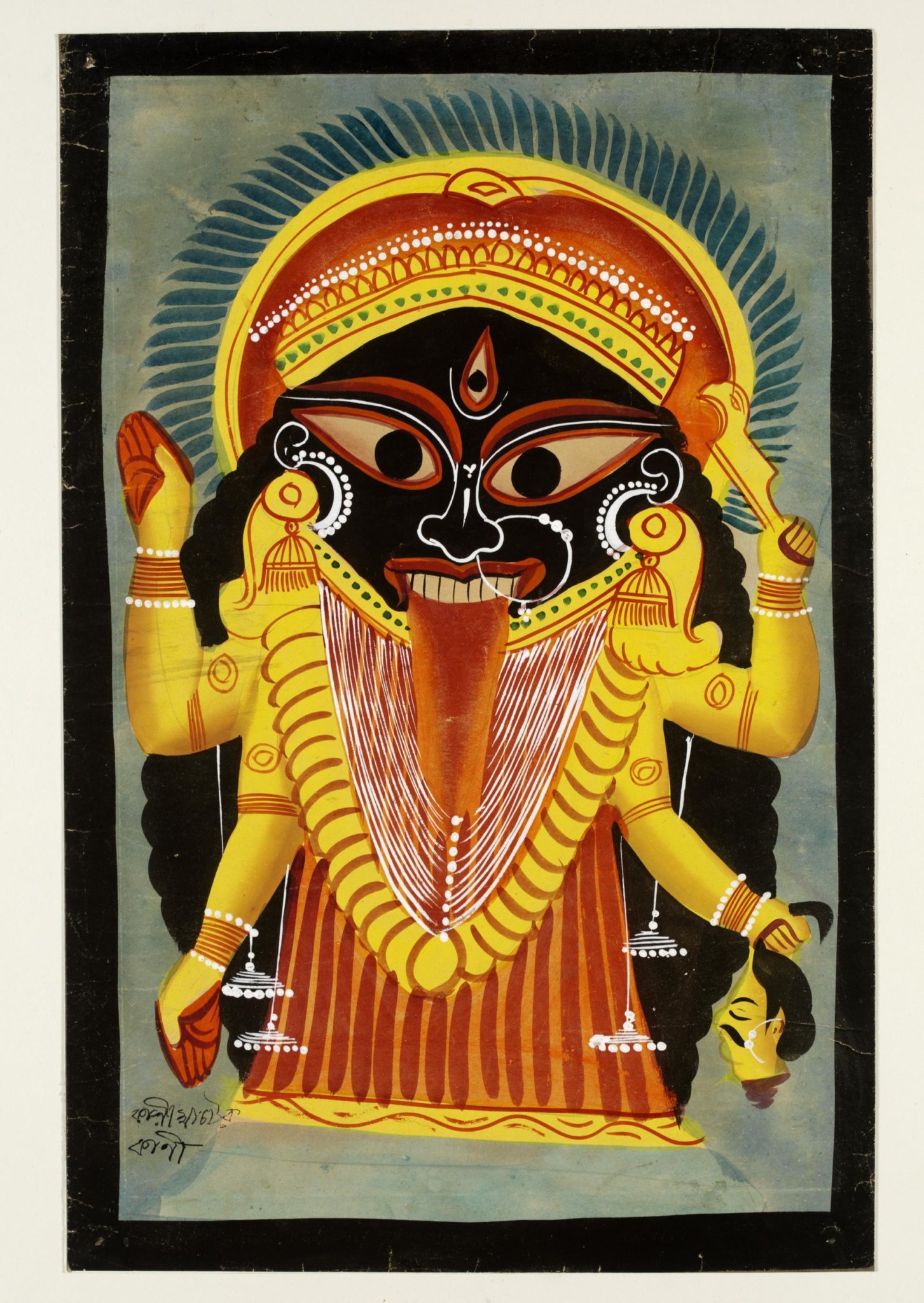
KALIGHAT PAINTING /An Indian folk art /Easy Kalighat painting / A Beautiful Lady YouTube
Kālīghāṭ painting, short-lived style of watercolour painting produced in the 19th century in India by artists in the Calcutta marketplace for sale to pilgrims visiting the Kālīghāṭ temple. The style is characterized by broad sweeping brush lines, bold colours, and simplification of forms suitable for their mass production.

KALIGHAT Folk art painting, Madhubani art, Kalighat paintings
April 13, 2023 5 min read Kalighat painting, also known as Kalighat Patachitra, is a traditional art form that originated in the 19th century in the vicinity of the Kalighat Temple, in Kolkata, West Bengal. These paintings depict the everyday life and social norms of the people living in the area.

Kalighat Painting by artist Unknown Artist Folk, Painting Mojarto 217868
Kalighat painting is a traditional Indian form of art that originated in the colonial atmosphere of Calcutta in the 19th century. The Kalighat Kali Temple is the birthplace of these paintings, and this traditional form of painting owes its name.

34 best images about Kalighat Paintings on Pinterest Folk art, The goddess and Folk art paintings
Mythology and Religion In villages, the patachitra form was creating a dynamic oral tradition, aided by visual art. The subjects of the scrolls were mostly religious in nature where both Hindu and Muslim tales were depicted, the most famous being parts of Ramayana and stories on the lives of popular Islamic saints.[5]

KALIGHAT PAINTING Folk art painting, Indian folk art, Contemporary art painting
Traditional Folk Art: Kalighat Pat Paintings The Kalighat pat painting style originated in rural Bengal. In the rural villages, skilled artists used to paint narrative stories on scrolls of handmade paper, which stretched over 20 ft. (6 m) in length and were known as patachitras.

Oxford Digital Library Kalighat paintings separate sheets Indian folk art, India art
Kalighat painting, an extraordinary style of Indian folk art, originated in the 19th century within the vibrant Kalighat area of Kolkata (formerly Calcutta), West Bengal, India. It emerged during a period of profound social and cultural change in colonial India, and quickly gained popularity as a unique and expressive form of artistic expression.

KALIGHAT Tribal art, Folk art painting, Contemporary art painting
Kalighat painting or Kalighat Pat originated in the 19th century in West Bengal, India, in the vicinity of Kalighat Kali Temple , Kalighat , Calcutta, India. From being items of souvenir taken by the visitors to the Kali temple, the paintings over a period of time have developed as a distinct school of Indian painting.
.jpg?mode=max&width=1025)
SEVEN KALIGHAT PAINTINGS, INDIA, BENGAL, 19TH CENTURY Christie’s
Kalighat 'patuas' (painters) produced these cheaply made works of art to make a living by selling to a mass market. The V&A holds the largest collection of Kalighat paintings in the world. The collection, which numbers about 645 watercolour drawings and paintings, also includes line drawings and hand-coloured lithographs.

Villagers Collecting Date Palm Sap Kalighat Painting Indian art paintings, Contemporary folk
Culture Meet the greatest modernists of the Indian folk art From Bhuri Bai, a pioneering Bhil artist, to Jivya Soma Mashe, a renowned Warli modernist, these revolutionaries gave Indian folk art a contemporary canvas. By Gautami Reddy and Amit Kumar Jain 1 January 2023
ParsaReport Kalighat paintings confusing conjunction of old and new
Folk art has many forms in India but it is only in recent years that it has received its due attention. In a nation that comprises 35 states, each distinct cultural and traditional identity is displayed in the folk art of the region.. Almost a world apart are the Kalighat style of paintings which was born in the market places of Kolkata.

Kalighat Painting Indian folk art, Kalighat paintings, Indian paintings
It originated in the 19th century in West Bengal, India, in the vicinity of Kalighat Kali Temple, Kalighat, Calcutta From the depiction of Hindu gods, god, and other mythological characters, the Kalighat paintings developed to reflect a variety of subjects, including many depictions of everyday life

Kalighat paintings separate sheets India art, Hindu art, Folk art painting
That's when I decided to learn more about the art form and revive it," Kalam says. More here: Warli painting: Maharashtra's 10th-century tribal folk art moves from mud walls to modern living rooms. Revival and contemporisation of Kalighat paintings. Kalam began by observing the old Kalighat paintings in museums and people's homes.

Kalighat Painting A Hugedemanded Artwork in West Bengal Indian art gallery, Indian art
One of the first descriptions of Kalighat paintings was by art collector Ajit Ghose: The drawing is made with one long bold sweep of the brush in which not the faintest suspicion of even a momentary indecision, not the slightest tremor, can be detected.

Souvenir Art The Divine Comedy of Calcutta’s Kalighat Paintings Sarmaya
Kalighat paintings, as the name suggests, were created in the Kali Temple area on the ghat (bank) of the Burin Ganga (a canal diverging from the Ganges River) in south Calcutta (Figs. 1, 3). From at least as early as the 1830s until the 1930s, the images were painted and sold as pilgrimage and tourist souvenirs, not only in the shops and stalls lining the alleys of the Kalighat area but also.

Kalighat Painting by artist Unknown Artist Folk, Painting Mojarto 265076
Kalighat painting developed in the mid-19th century in Kolkata (formerly Calcutta) to illustrate the Hindu gods and goddesses and respond to topical social and political events affecting the.

Kalighat paintings from Bengal, India Indian folk art, Indian art paintings, Hindu art
Kalighat painting, Kalighat Patachitra, or Kalighat Pat (Bengali: কালীঘাট পটচিত্র) is style of Indian paintings which originated in the 19th century.